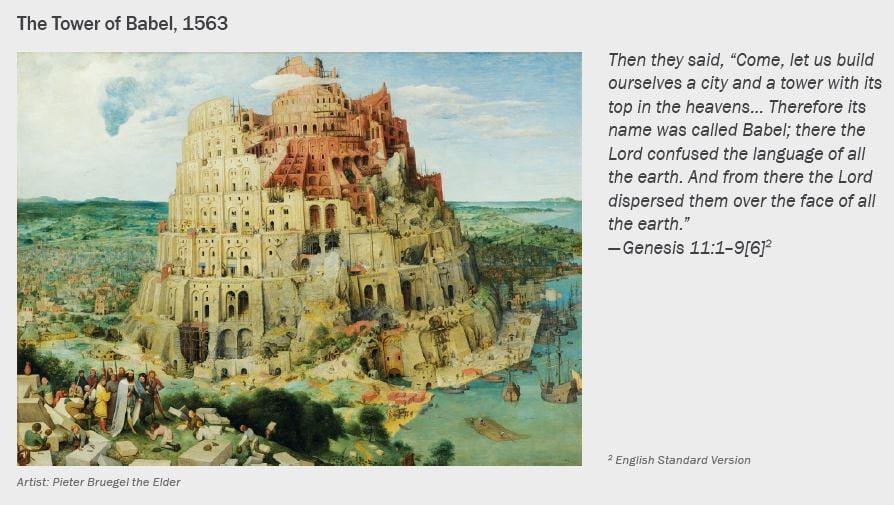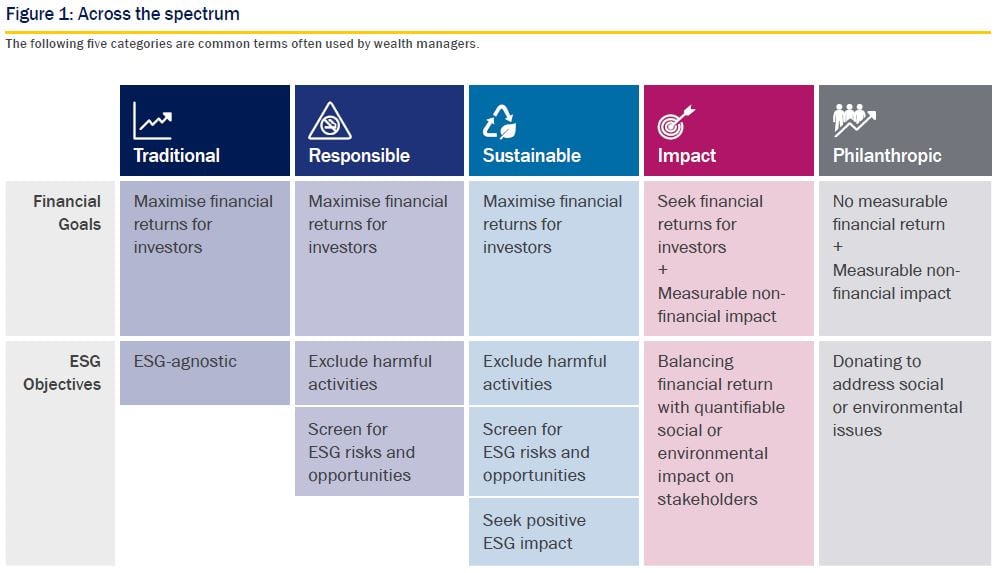Wealth Management: Mosaique Insights – The language of responsibility

Michel van der Spek, Co-Head of Portfolio Management (New Court), and William Haggard, Head of Investment Insights, Rothschild & Co Bank AG
An understanding of vocabulary has become increasingly important in this rapidly evolving area of finance
Many years ago, the Babylonians settled in a land named Shinar. The population was growing and they all spoke one language. The inhabitants decided to build a tall, proud symbol to show the greatness of their nation. The Babylonians wanted a tower that would reach the heavens, so they started constructing a great ziggurat - a stepped tower in a pyramid shape as depicted by the famous Flemish artist Pieter Bruegel the Elder (see 'The Tower of Babel, 1563' below).
God, however, did not like the pride and arrogance of the people and caused them to suddenly speak different languages so they could not communicate and work together to build the tower. This caused people to scatter across the land. The unfinished tower and city - which now lies in ruins in modern-day Iraq - was called Babel, meaning 'confusion'.
The story of the Tower of Babel is a metaphor to warn against humanity's vanity. It also illustrates the power of a common language and the confusion that follows when our common lexicon is broken. We believe this story provides a timely reminder of the importance of setting out a common language for those who want to incorporate environmental, social and governance (ESG) factors into their investment processes.
As discussed in our publication Combining business with humanity, assets invested across the ESG spectrum have tripled in the last decade. As the drumbeat of ESG has grown louder, many terms have emerged that describe similar investment strategies. The lack of a common language in this field is confusing for everyone involved and an obstacle to our discussions on the topic of ESG investing. As mentioned by our colleagues in the interview 'Calling Frankfurt', we at Rothschild & Co Wealth Management seek to address this lack of clarity and ensure our clients clearly understand the various terms frequently used in this rapidly evolving area of finance (Figure 1).1
1The terms used by Rothschild & Co Wealth Management in this article are flexible and there to provide useful guidance.
Source: Rothschild & Co Wealth Management
From traditional to philanthropic: understanding the differences
(i) Traditional
In traditional investing, the main objective is to maximise financial returns. While ESG factors may be considered in the analysis and selection of securities, these are disregarded if there is a conflict with the pursuit of maximising profit. Traditional investing is ultimately 'ESG-blind', due in part to its tendency to focus solely on shorterto mid-term financial gain.
(ii) Responsible
Responsible investing often integrates ESG factors into the investment process with the aim of identifying material risks to the long-term value of the businesses we invest in. As a first step in this process, most investors exclude a prescribed list of activities that are deemed harmful to society or the environment, such as anti-personnel mines, human trafficking or pornography (read more in 'Beyond shareholder value'). Once businesses connected with these activities are excluded, ESG factors are used as a risk management tool, to analyse and identify risks that could materially affect the value of a client's portfolio (see box 'Seeing smoke').
Seeing smokeIn 2018, General Electric (GE) had to write off $23 billion of accrued goodwill from its power equipment division that supplied goods to the electricity industry. A considerable amount of that accounting goodwill had arisen from a 2015 acquisition of an energy business. In the intervening three years, the outlook for this division deteriorated markedly as industry sentiment turned against fossil-fuel dependency. As a portfolio manager, responsible investing would require us to look at GE's power equipment business, its end-users and the fossil-fuel dependency of this business model. This would help us identify any risks in current goodwill valuations. By investing responsibly, we can avoid negative ESG outcomes and make investment decisions that help to maximise financial returns for our clients. |
The aim of responsible investing to maximise financial returns while avoiding risk through the integration of ESG factors is shown in numerous academic studies to be highly effective.2 These studies highlight the long-term positive performance of companies that take ESG factors into consideration compared with their ESG-blind peers.
2Particularly in emerging markets - see our article ESG in managing wealth in our autumn 2019 publication, Combining business with humanity.
Responsible investing can be implemented across a variety of investment philosophies. One can, for example, combine a benchmark-oriented strategy with a selection of securities based on a best-inclass approach.3 Alternatively, one can combine a bottom-up investment strategy with a focus on material ESG factors and exclusion criteria.
3The selection of securities which outperform their sectoral peers on an ESG basis.
There is no right or wrong - the important thing is that the analysis of ESG factors is integrated into the investment process primarily to identify and avoid risk.
(iii) Sustainable
A sustainable investment approach often takes ESG integration into the investment process one step further. ESG factors are applied to our security screening to:
- Identify ESG-related risks in portfolios (responsible investing).
- Invest in businesses that help to achieve social or environmental objectives, such as those in the 2015 Paris Agreement on climate change (read more in 'A new wave of awareness').
A sustainable investment approach will still seek to maximise financial returns while adhering to the two steps above. The link between a company's activities and achieving positive social or environmental objectives must be clear, but not necessarily measurable in empirical terms (see 'Impact'). It will, however, require an assessment of that activity's effect on a broader set of stakeholders - not just shareholders - including employees, customers, suppliers and the wider environment. Specific examples of sustainable investments are green bonds, where the financing is directly linked to economic activities that support climate and environmental projects.
(iv) Impact
Impact investing addresses specific environmental or social problems by achieving measurable non-financial, as well as financial, returns. A variety of strategies from venture capital and private markets through to microfinance funds and impact bonds can be used to deliver this social or environmental impact. A key difference with sustainable investing is that impact investing will balance the delivery of financial returns with achieving measurable social or environmental impact and can, in some cases, prioritise the latter.
For more information on how to measure impact in the context of a microfinance strategy, please read our interview, Microfinance as a source of impact, with Constantin Augier from our Asset Management division. From climate change funds to conservation finance and microfinance lending, impact investing is playing an increasingly important role in addressing specific social or environmental needs.
(v) Philanthropic
Finally, and at the far end of the ESG spectrum, there is philanthropic. In philanthropic ventures, a person or institution focuses on giving money to a specific cause or good without expecting a financial return or even a return on capital. The focus is on alleviating social or environmental problems through philanthropic donations or activities and is separated from mainstream ESG finance.
Looking beyond Babel
The ESG spectrum provides a sliding scale between the pursuit of financial return to the giving of money, with plenty in between. With this variety of approaches, linguistic confusion remains one of the greatest barriers to investing in this space. Returning to the theme of language, it is with some irony that today's online translation tool BabelFish seeks to unlock the linguistic chaos which followed the rise and fall of the Tower of Babel. At Rothschild & Co Wealth Management, ensuring we speak a common language when it comes to the ESG spectrum is the first important step to providing clear ESG advice to our clients.

